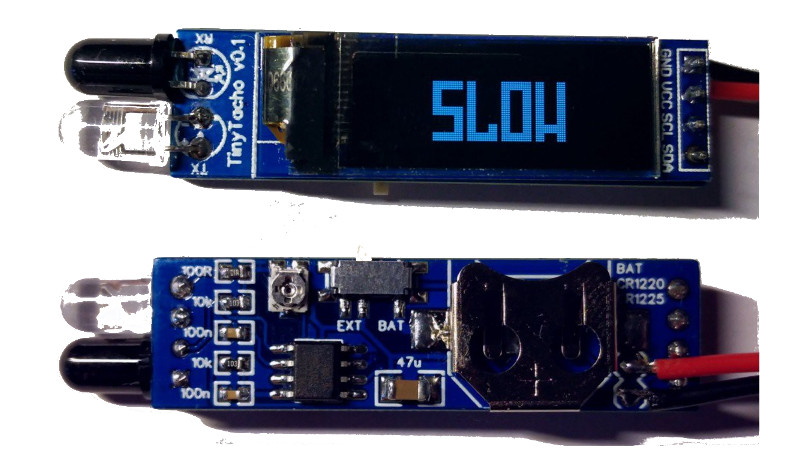An electronic tachometer is a straightforward enough device, in which the light reflections from a white spot on a rotating object are detected and counted over time, measuring the revolutions per minute (RPM). It’s a technique that has its roots in analogue electronics where the resulting pulses would have fed a charge pump, and it’s a task well suited to a microcontroller that simply counts them. But do you need an all-singing, all-dancing chip to do the job? [Stefan Wagner] has done it with a humble ATtiny13.
His TinyTacho is a small PCB with an IR LED and photodiode on one end, a small OLED display on its front, and a coin cell holder on its rear. The electronics may be extremely simple, but there’s still quite some effort to get it within the ATtiny’s meagre resources. Counting the revolutions is easy enough, but the chip has no I2C interface of its own and some bitbanging code is required. You can find all the design files and software you need in a GitHub repository, and he’s put up a video of the device in action that you can see below the break.
Tachometers are a popular project hereabouts, and we’ve featured a lot of them over the years. Perhaps the best place to direct readers then is not to another project, but to how to use a tachometer.
















19K rpm from that little motor? I wouldn’t have thought so…
and looking at the original greatscott video -he starts with his 28eur tacho being pathetic, and does hi own. The trouble is my less that $10US one from china does it within about 1% without a problem (yes, I’ve tested it) so I susoect he had either a broken or dodgy unit..
I was going to make the same comment, I can’t possibly imagine that’s right either.
Maybe it sounds even more unreasonable in kph.
Approx. 4cm diameter tire with 12.5cm circumference result in around 2380 m/min or 143 kph.
I would assume to see burn marks and some smoke during “touchdown” in the video.
I think it’s counting reflections from the treads. He needs to have some kind of reflective index mark on the tire…
Where do I buy one? And what are the wires for if there is a coin cell?
The coin cell is not populated in the video.
Challenge: Do it without the line…..
Record the raw signal for a set amount of time, do a little pattern analysis, when you see xyz repeat within a certain threshold, increment the count and update the model. Potentially add a few settings for regularly patterned surfaces, say the number of treads around a tyres circumference, as a divisor, for example, in theory it’s possible.
I’m just imagining police laser scanning tires, for tread depth, as people are driving along, scary Orwellian thought, I really shouldn’t give them ideas.
Roger that. Likin’ that idea. I’ll get on a proto and patent.